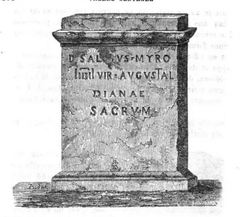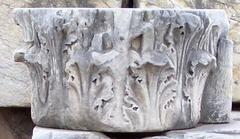
Roman Amphitheatre of Aoste: Visiting Hours, Tickets, and Historical Sites Guide
Date: 04/07/2025
Introduction
Nestled in the heart of Aosta, Italy, the Roman Amphitheatre of Aoste is a striking testament to ancient Roman ingenuity and civic life. Established as part of Augusta Praetoria Salassorum in 25 BCE, the city served both strategic and cultural roles in the Roman Empire. Unique among Roman amphitheatres, Aosta’s structure was constructed within the city’s fortified walls, symbolizing its significance as a social, entertainment, and administrative hub. Today, the amphitheatre’s remains—set amid the medieval Convent of Santa Caterina—offer visitors a tangible link to both Roman and subsequent medieval histories.
This comprehensive guide details everything you need to plan your visit: opening hours, ticketing, accessibility, recommended tours, and essential travel tips. Nearby sites such as the Roman Theatre, Porta Praetoria, and Aosta Cathedral are also featured to help you maximize your exploration of the city’s rich heritage. For up-to-date information, refer to official tourism resources and heritage websites (visititaly.eu; italyastheromansdid.it; valledaostaheritage.com).
Table of Contents
- Introduction
- Roman Origins and Foundation of Augusta Praetoria
- Construction and Architectural Features
- Cultural Significance
- Visiting the Roman Amphitheatre of Aoste
- Nearby Attractions
- Archaeological Rediscovery and Preservation
- Visual and Interactive Resources
- Frequently Asked Questions (FAQ)
- Conclusion
Roman Origins and Foundation of Augusta Praetoria
Augusta Praetoria Salassorum (modern Aosta) was established in 25 BCE following Rome’s conquest of the Salassi tribe. The settlement was a keystone in Roman efforts to control Alpine trade and military routes. Planned on a classic Roman grid, the city’s defensive walls and monumental gates, such as Porta Praetoria, endure as reminders of its strategic and cultural prominence (visititaly.eu; italyweloveyou.com). Within this framework, public buildings—including the amphitheatre—were constructed to serve the community’s civic and entertainment needs.
Construction and Architectural Features
Constructed during the reign of Emperor Claudius (41–54 CE), the Roman Amphitheatre of Aoste was uniquely built within the city walls, close to the Porta Praetoria and adjacent to the Roman Theatre (weirditaly.com; valledaostaheritage.com). Unlike most Roman amphitheatres, which stood outside urban boundaries, Aosta’s occupied two city blocks in the northeastern quarter, underscoring its importance in daily life (fr.wikipedia.org). Built from local stone and Roman concrete (opus caementicium), the amphitheatre showcased the adaptability of Roman engineering to Alpine conditions. Its elliptical arena, tiered seating (cavea), and efficient access corridors (vomitoria) could accommodate several thousand spectators.
Fragments of decorative cornices and reliefs hint at a once-elegant façade, while the proximity to other Roman monuments reflects a cohesive urban design (italyastheromansdid.it; livetheworld.com).
Cultural Significance
In Roman times, the amphitheatre was an epicenter for gladiatorial games, animal hunts, and public ceremonies—events that both entertained and reinforced the social order. These spectacles fostered civic pride and marked imperial generosity, while also serving as venues for political announcements and military celebrations (italyastheromansdid.it). Archaeological evidence from the surrounding area, including early Christian burials and basilicas, reveals the site’s evolving religious and social roles across centuries.
Today, the amphitheatre and nearby Roman Theatre continue to host cultural festivals and performances, maintaining a tradition of public gathering and community engagement (livetheworld.com). Educational programs, offered in collaboration with the Aosta Regional Archaeological Museum, further enrich the visitor experience.
Visiting the Roman Amphitheatre of Aoste
Visiting Hours
The amphitheatre is generally open for guided tours and during special events, with standard hours from 10:00 AM to 6:00 PM, Tuesday through Sunday. Since hours can vary by season and event, always confirm current schedules via the official Aosta tourism website or local visitor centers.
Tickets and Admission
Admission is often included in a combination ticket covering key archaeological sites such as the Roman Theatre, Porta Praetoria, and the Archaeological Museum. Tickets typically range from €5 to €12, with discounts for students, seniors, and groups. Children under 12 may enter free. Online booking is recommended during peak periods.
Accessibility
Due to the amphitheatre’s ancient and partially ruined state, accessibility is limited. Visitors with mobility challenges should inquire in advance about available accommodations or alternative visit options.
Guided Tours and Educational Programs
Guided tours led by expert archaeologists or licensed guides are highly recommended for deeper insight into the site’s history and significance. Educational activities are occasionally available for school groups and visitors of all ages.
Travel Tips
The amphitheatre is centrally located and easily reached on foot from the main train station or bus stops. Wear comfortable shoes for uneven terrain, and plan to visit nearby markets and cafes to enjoy local culture.
Nearby Attractions
In addition to the amphitheatre, Aosta boasts several noteworthy historical sites:
- Roman Theatre: Renowned for its impressive façade and acoustics.
- Porta Praetoria: A monumental Roman gateway still standing.
- Cryptoporticus: An underground corridor system once used for storage and processions.
- Aosta Cathedral: Featuring architectural elements from the Romanesque, Gothic, and Renaissance periods.
These sites are easily accessible on foot and offer a comprehensive view of Aosta’s layered history (nomadicsamuel.com).
Archaeological Rediscovery and Preservation
Rediscovered and studied from the 19th century onward, the amphitheatre has undergone several restoration campaigns to stabilize and interpret the remains (valledaostaheritage.com). The site is integrated within the medieval Convent of Santa Caterina’s grounds, where an orchard now occupies the ancient arena (fr.wikipedia.org).
Visual and Interactive Resources
Onsite information panels, detailed maps, and virtual tours—available through Aosta’s official tourism website—provide immersive experiences for all visitors. High-quality images and drone footage further illustrate the amphitheatre’s setting and structure.
Frequently Asked Questions (FAQ)
Q: What are the visiting hours of the Roman Amphitheatre of Aoste?
A: Typically, 10:00 AM to 6:00 PM, Tuesday through Sunday. Confirm with official sources for seasonal changes.
Q: Is the site wheelchair accessible?
A: Accessibility is limited due to ancient structures. Contact site administration for assistance.
Q: Are guided tours available?
A: Yes, often as part of combined visits with other Roman sites.
Q: Can I purchase tickets online?
A: Tickets are available online via official tourism portals and at local visitor centers.
Q: What other sites are nearby?
A: The Roman Theatre, Porta Praetoria, Cryptoporticus, and Aosta Cathedral.
Roman Theatre of Aosta: Visiting Hours, Tickets, and Visitor Guide
Introduction
The Roman Theatre of Aosta is another highlight of the city’s Roman heritage. Built soon after the city’s founding, it accommodated more than 3,000 spectators and was central to both civic and entertainment life. Notable for its monumental 22-meter façade, the theatre remains one of the best-preserved examples in the Alps (Italia.it).
Visiting Information
Current Status:
As of July 2025, the Roman Theatre is closed for restoration, with reopening expected in autumn 2025. Always check the official website for updates.
Typical Opening Hours:
- April–September: Daily, 9:00 AM – 7:00 PM
- October–March: Daily, 10:00 AM – 1:00 PM and 2:00 PM – 5:00 PM
- Closed December 25 and January 1
Tickets:
Entry is included in a combination pass covering several archaeological sites.
- Full price: €10.00
- Reduced: €8.00 (groups or with tour guide)
- Youth (19–25): €3.00
- Free: children/youth (0–18), school groups, visitors with disabilities and their companions
See the official ticket page for the latest prices.
Accessibility:
The site is generally accessible, though some areas may be affected during restoration. Check current details before visiting (mypathintheworld.com).
Highlights and Practical Tips
- The theatre’s façade features three tiers of arched windows, and the semicircular cavea seated over 3,000 people.
- Evening illuminations offer a dramatic view of the ruins (thetravel.com).
- Guided tours in multiple languages can be arranged (Aosta tourist office).
- The site is easy to reach from the city center and near other attractions, restaurants, and cafes (marthasitaly.com).
- Combination tickets offer access to multiple sites.
- Plan to visit in spring or early autumn for pleasant weather and beautiful Alpine views.
Summary & Travel Advice
The Roman Amphitheatre of Aoste is a living monument, offering insight into Roman urbanism, entertainment, and social life in the Alps. Preserved through careful stewardship, it stands alongside the Roman Theatre and other sites to create a richly layered historical experience. By planning your visit with attention to opening hours, ticketing, and accessibility, you’ll enjoy a rewarding journey through Aosta’s ancient and modern heritage. For the latest news, restoration updates, and event schedules, consult official tourism resources and download the Audiala app for enhanced experiences and notifications.
References
- Roman Amphitheatre of Aoste: Visiting Hours, Tickets, and Historical Insights for Travelers
- Discover the Roman Amphitheatre of Aosta: History, Architecture, and Visitor Information
- Roman Amphitheatre of Aoste Archaeological and Heritage Site
- Roman Theatre of Aosta: History, Visiting Hours, Tickets, and Visitor Guide






